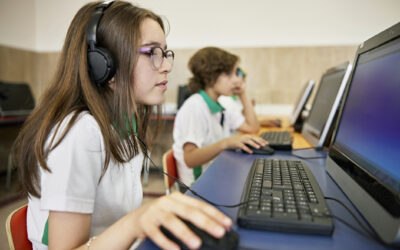Another sign of the momentum around this topic: today, in 29 states plus the District of Columbia, computer science credits can count toward high school graduation math and/or science credits—this number is up from 12 states just 3 years ago!
A few things about this are interesting to me. First, teaching Computer Science in K-12 schools is not new. This subject has been taught for decades, mainly in high schools and as an elective. What IS new, and exciting, is the recent emphasis on teaching Computer Science and Computational Thinking to ALL students, at ALL grade levels. There is a growing acceptance that CS/CT should be treated as a “fifth core subject”, on par with math, science, language arts and social studies—and even our youngest students should have some early exposure to the topic.
Also interesting is the increasing recognition that learning CS/CT is not only appropriate for those who intend to pursue careers in programming or technology. The study of CS/CT provides skills which are applicable in many professions, in fields as diverse as retail, healthcare, manufacturing, entertainment, agriculture, and transportation among others. Employers value the skills that students learn in studying computational thinking and coding–such as problem solving, creative thinking, analysis, and logically organizing data. No longer is the study of computer science just for the “geeks”.
Here at Learning.com, we are excited to see these developments. For over 15 years, we have been working with school districts around the country to provide a technology literacy and pre-computer science curriculum for K-8 students. Our core product, EasyTech, covers many of the standards included in the Computer Science Teachers Association (CSTA) standards for K-8 students. We deliver this offering today in more than 1 in 6 districts across the nation, in roughly 15,000 schools.
Earlier this year, we announced the development of our new Foundations of Coding/Computational Thinking lessons for grades K-8 (available for back to school this Fall). This week, we are excited to announce the introduction of EasyCode, an additional set of coding activities and exercises for students in grades 3-8. With EasyCode, we provide a hands-on experience with a real coding language (Coffeescript), giving students the ability to write code to solve problems, test their solutions and receive feedback. And all delivered in a fun, gamified environment that, I have to say, is quite addictive!
As mentioned in the linked PBS article above, one challenge facing districts is the lack of teachers who are trained to teach computer science. We have been helping districts address this problem for 15 years, and EasyCode provides great lesson plans, teacher support, and a variety of implementation options that ease the introduction of these activities into a variety of classroom or lab settings.
Click here to learn more about EasyCode.

Keith Oelrich
CEO
Keith Oelrich joined Learning.com as CEO in 2012. A pioneer in the K-12 online education market since 2000, Keith has served as CEO of several companies which have collectively provided K-12 online education programs to thousands of districts, tens of thousands of schools and millions of students and their families.
Further Reading
Guide to Teaching Algorithms in Computer Programming for K-12 Students
Algorithms are the heart of computer programming, providing the step-by-step instructions that computers follow to perform tasks and solve problems....
Planning Digital Literacy Assessment: A Simplified Approach
As educators know, assessments are critical to the learning process. They provide beneficial self-checks to students, informative results to...
Technology Skills to Teach Gen Z for Future Success
Gen Z and Gen Alpha will enter a workforce that looks very different than the one their parents and grandparents experienced. Educators know it’s...



